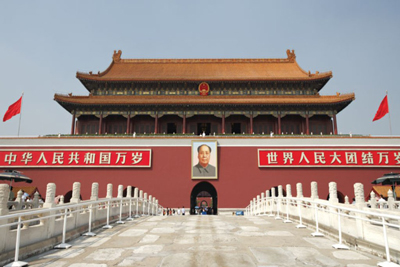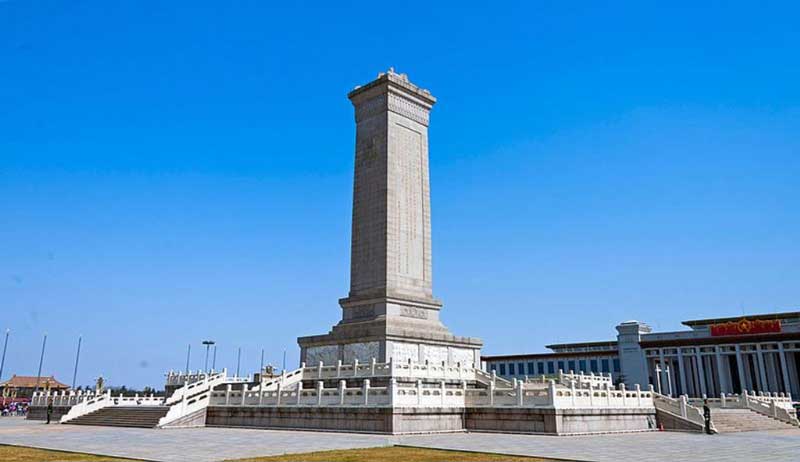
Tiananmen Square, locally known as Tiananmen Guangchang, an open city square in the city centre of Beijing, is named after the massive Tiananmen, the Gate of Heavenly Peace, and is rated as one of the largest public squares in the world. Tiananmen, located to the north of the square, was probably first constructed around 1415 during the Ming dynasty and once served as the main gate to the Forbidden City. Although the Tiananmen Square was originally designed and built in 1651, it was enlarged several times until it attained the present shape in 1959.
Mao Zedong, the founder of the People’s Republic of China, had the vision to make the square the largest in the world, sufficiently large enough to hold more than 5000,000 people. Inspired by his vision, a major expansion of the square started in November 1958, and the mission was completed in August 1959, not before bulldozing and demolishing numbers of residential and other buildings in the process. Covering an enormous area of 2,510 X 925 feet (765 x 282 m), Tiananmen Square has great cultural significance and was the site of several memorable events in Chinese history, which include the proclamation of founding the People’s Republic of China on the 1st day of October 1949, by Chairman Mao. Apart from Monument to the People’s Heroes, a ten storey obelisk, located in the southern part of Tiananmen Square, it also contains several important buildings like the Great Hall of the People, the National Museum of China, and the Mausoleum of Mao Zedong.

Although commissioned in 1949, the 124.5 feet (37.94 m) tall Monument to the People’s Heroes made of Qingdao granite was completed only in 1958. Constructed as a national monument on a two-tiered marble terrace in the centre of the square, it was dedicated to the martyrs of revolutionary struggles during the 19th and 20th centuries.
Designed by architect Liang Sicheng, with some elements designed by his wife, Lin Huiyin, it served as the ground zero for the student protesters during the pro-democracy demonstrations of 1989. The sides of the pedestal contain huge bas-reliefs depicting eight major patriotic and revolutionary events in the history of China, starting from the destruction of opium at Humen in 1839 to the Yangtze River Crossing Campaign to capture Nanjing during the Chinese Civil War in 1949.

The Great Hall of the People, located at the western edge of Tiananmen Square was opened in September 1959 as one of the Ten Great Constructions completed for the 10th Anniversary of the PRC. The 183.72 feet (56 m) long and 677.50 feet (206.5 m) wide hall was designed to symbolize the national unity and ethnic equality of the nation. Apart from the meeting place for the full sessions of the National People’s Congress (NPC), the Chinese legislature, it is also the venue for the National Congress of the Communist Party of China (NCCCP), and is used for many other special events, including national-level meetings of various social and political organizations, large anniversary celebrations, as well as memorial services for former leaders.
With the ceiling of the hall resembling a starry sky, decorated with a galaxy of lights, and a large red star at the centre of the ceiling, along with a pattern of water waves, the Great Hall is the largest auditorium of China.

The National Museum of China, one of the largest museums in the world, is located on the eastern side of Tiananmen Square. It was established in 2003 by the merger of two separate museums housed in the same building since 1959, namely the Museum of the Chinese Revolution in the northern part and the National Museum of Chinese History in the southern wing. The National Museum of Chinese History, dedicated to the task of safeguarding Chinese history from its earliest until the Chine Revolution, was established in 1912, and the Museum of Chinese Revolution, initially started in the Office of the National Museum of the Revolution in 1950 to preserve the legacy of the1949 Revolution, particularly highlighting the role of the Chinese Communist Party. Completed in 1959, the four-story building of the National Museum of China, with a frontal length of 1027 feet (313 m), and a height of 130 feet (40 m), complements the opposing the Great Hall of the People, built at the same time.

The Mausoleum of Mao Zedong, a prominent landmark in the middle of Tiananmen Square, was constructed just ten months after his death in September 1976. The central hall of the mausoleum contains the embalmed body of Chairman Mao, in a crystal cabinet, draped in a red flag adorned with hammer and sickle.
Apart from all the above, a statue with a torch in her hand, representing the Goddess of Democracy and Freedom, resembling the western icon of Liberty, was erected in the square in 1989. Although tree lines decorate its east and west edges, the open square is devoid of greenery and benches for taking a rest or gossip at leisure. Instead, it has large lamp posts, fitted with video cameras, and is heavily monitored by uniformed and plain-clothes police officers.

From its inception, Tiananmen Square has witnessed several military displays and ceremonial parades, which included 1984, 1999, and 2009 military parades for celebrating the 35th, 50th, and 60th anniversary of the People’s Republic of China.

Tiananmen Square has also been the site of several politically important events and student demonstrations. Most notable among those events include the May Fourth Movement in 1919, the proclamation of the People’s Republic of China by Chairman Mao Zedong in October 1949, and the Tiananmen Square protests of 1989, known in China as the June Fourth Incident, which was a student-led demonstration. Widely associated with questioning the legitimacy of the one-party rule of the Communist Party in Chins, the last incident in the list later came to be known in history as the Tiananmen Square Massacre when troops armed with assault rifles and accompanied by army tanks fired indiscriminately at the unarmed demonstrators, killing several hundred to several thousand, with thousands more seriously wounded.